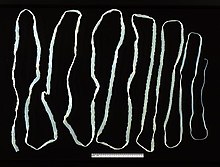Taenia (flatworm)
| Taenia | |
|---|---|

| |
| Taenia saginata | |
| Scientific classification | |
| Domain: | Eukaryota |
| Kingdom: | Animalia |
| Phylum: | Platyhelminthes |
| Class: | Cestoda |
| Order: | Cyclophyllidea |
| Family: | Taeniidae |
| Genus: | Taenia Linnaeus, 1758 |
| Type species | |
| Taenia solium Linnaeus, 1758
| |
Taenia is a genus of tapeworm that includes some important parasites of livestock. Members of the genus are responsible for taeniasis and cysticercosis in humans. There are more than 100 species recorded. They are morphologically characterized by a ribbon-like body composed of a series of segments called proglottids; hence the name Taenia (Greek tainia meaning ribbon, bandage or stripe). The anterior end of the body is the scolex. Not all members of the genus Taenia have an armed scolex (hooks and/or spines located in the "head" region), for example, Taenia saginata has an unarmed scolex, while Taenia solium has an armed scolex.[1]
Proglottids have central ovary, with a vitellarium (yolk gland) posterior to it. As in all cyclophyllid cestodes, there is genital pore on the side of the proglottid. Eggs are released when proglottid deteriorates, and so a uterine pore is unnecessary.
Selected species
- Taenia asiatica – Asian Taenia. Humans as definitive hosts, pigs and rarely cattle, as intermediate hosts.
- Taenia crassiceps
- Taenia gonyamai, parasite of antelope (larval-) and lions (adult forms).[2]
- Taenia mustelae, which infects small carnivorans.
- Taenia pisiformis, which is common in wild dogs and in rabbits, who serve as intermediate hosts.
- Taenia rileyi, which infects bobcats.
- Taenia saginata – beef tapeworm. Infects cattle and humans, and can only reproduce while in the human gut.
- Taenia solium – pork tapeworm. Like T. saginata humans serve as its primary host, and it can only reproduce by the dispersal of proglottids while in the gut. These reinfect pigs when human faeces is improperly disposed of. This infection is most common in parts of Africa.
- Taenia taeniaeformis, which uses rodents as intermediate hosts and then inhabits cats as the definitive host.
Life cycle
The life cycle begins with either the eggs or the gravid proglottids being passed in the feces, which can last for days to months in the environment. Sometimes these segments will still be motile upon excretion— they will either empty themselves of their wikt: oncospheres within a matter of minutes or, in some species, will retain them as a cluster and await the arrival of a suitable intermediate vertebrate host. The intermediate host (cattle, pigs, rodents, etc., depending on the tapeworm species) must then ingest the oncosphere or proglottids. If the host is a correct one for the particular species of tapeworm, the oncospheres then hatch, transforming into hexacanth embryos in the small intestine of the intermediate host and invade the intestinal wall to travel to the striated muscles to develop into cysticerci. Here they will grow, cavitate, and differentiate into a second larval form shaped like a bladder (and erroneously believed until the middle of the 19th century to be a separate parasite, the bladderworm) which is now infectious to the definitive host. To continue the process, the definitive host must eat the uncooked meat of the intermediate host. Once in the small intestine of the definitive host, the bladder is digested away, the scolex embeds itself into the intestinal wall, and the neck begins to bud off segments to form the strobila. New eggs will usually appear in the feces of the definitive host within six to nine weeks, and the cycle repeats itself.
Taenia saginata are about 1,000-2,000 proglottids long with each gravid proglottid containing 100,000 eggs, while Taenia solium contain about 1,000 proglottids with each gravid proglottid containing 60,000 eggs.[3]
Treatment
Treatment with Praziquantel (PZQ) has been approved by the U.S. Food and Drug Administration (FDA) and is quite effective.[3]
References
- ^ Roberts, L.S. and Janovy, John Jr. Foundations of Parasitology 7th Edition. McGraw-Hill. 2005.
- ^ Template:De iconSachs, R (1969). "Untersuchungen zur Artbestimmung und Differenzierung der Muskelfinnen ostafrikanischer Wildtiere". ZARRAYropenmedizin und Parasitologie. 20 (1): 39–50.
- ^ a b http://www.dpd.cdc.gov/DPDx/
